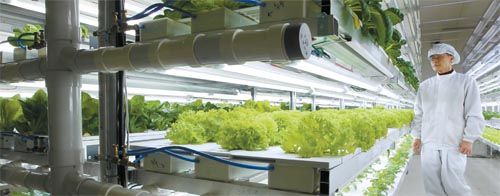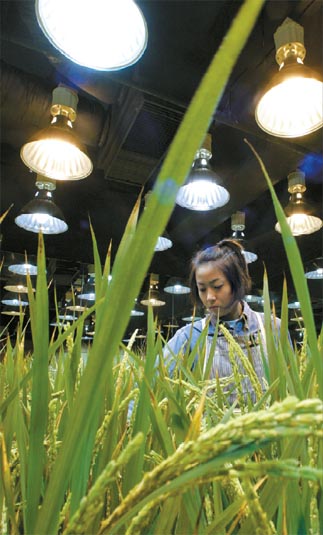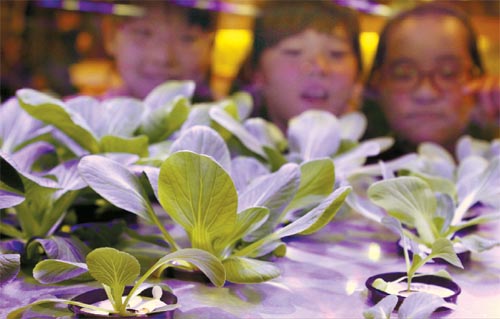Inside the future of farming

An Insung Tec employee tends to a plant factory in Yongin, Gyeonggi. By Cho Yong-chul
The exterior of a factory on regional road 321 in Yongin, Gyeonggi, does not provide any clues that anything out of the ordinary is happening inside.
Entering the plant, though, is anything but an ordinary procedure. Visitors first pass through an air curtain before being asked to put on laboratory coats. Another air curtain removes any germ-carrying particulate matter that the first one missed. After that, an “air shower” blasts subjects from both sides before they step onto the main floor of the plant. The procedure is similar to entering a semiconductor production facility.
Operated by Insung Tec, this Yongin factory is actually the site of the country’s first industrial vertical farm.
The 165 square meter (1,776 square feet) factory floor has four seven-level plant beds. Green sprouts rise from each fluorescent-lit level. Vegetables such as kale, romaine and green lettuce, and basil grow here, where nutrients are fed into the soil through tubes. There is no natural light, and the workers are more lab technicians than farmers.
“We have two layers of air curtains and an air shower to prevent outside diseases and insects from entering the facility,” said Byun Seung-sub, the head of the plant. “The biggest merit of this vertical farm is that we can produce pesticide-free vegetables year-round, regardless of weather and seasonal growing patterns that limit more traditional farming.”
In one corner of the farm, four KT employees are busy installing a remote control system for the project called Smart Green Farm. KT and Insung Tec are collaborating on the project. Other benefits of this vertical farm are reduced labor costs and a much quicker farm-to-market distribution ratio, made possible because vertical farms can be constructed nearer to, or inside, urban centers.
Commercially viable vertical farms yield 10 times the bounty per square meter than regular green houses. Vertical farms are capable of producing 3,080 heads of lettuce per 3.3 square meters annually, whereas greenhouses can grow 333 heads in the same amount of space and time.
Despite yield, labor cost and time-to-market distribution benefits, vertical farming remains hobbled by economic feasibility. Even with the use of energy efficient light-emitting diodes and specially designed fluorescent lights, energy costs take up the majority of the operational costs. The production of lettuce in vertical farms is twice as costly compared to lettuce grown in greenhouses.
Nevertheless, demand is rising for Insung Tec’s produce. Shinsegae Department Store sold vegetables produced by Insung Tec last June, and Lotte Mart introduced a vertical farm system at its Seoul Station location.
Forecasting a windfall after vertical farming reaches a critical mass and becomes commercially viable, companies have been working around the clock to find ways to cut energy costs.

A Pasona employee picks weeds at an indoor rice field being grown using artificial light and hydroponics in Tokyo. [REUTERS/YONHAP]
Kast Engineering sold its technology to 10 farms and research facilities in Hamyang County, South Gyeongsang, and in Goseong County, Gangwon, in the first year of sales in 2010.
Kast Engineering built a 132-square-meter vertical farm last October. The farm can produce 26 tons of lettuce per year, but it is mainly used for research and development. North Gyeongsang covered 50 million won ($44,500) of the plant’s 250 million won construction cost.
Korea’s conglomerates have also recognized the potential of vertical farming. LG CNS developed an information technology system that controls farms’ LED lights, humidity levels and growth rates. LG CNS sold the system to agricultural research facilities including the Gyeonggi-do Agricultural Research and Extension Services.
Factory managers can remotely control their vertical farms, no matter their distance from the actual production facility. The implications are enormous. A future is envisioned in which massive growth operations in multiple facilities are controlled by a central management team in one location.
Hyundai Department Store Co.’s Hyundai Green Food program started researching vertical farming at a 1,064-square-meter facility in Chonbuk National University’s LED Fusion Technology Center. Researchers from the university have been involved since February. There, plants are grown at a constant temperature of 25 degrees Celsius (77 degrees Fahrenheit) under 15 hours of direct blue LED light, which has a wavelength of about 475 nanometers. In this environment, produce grows two to three times faster than plants grown outdoors or in greenhouses.
Researchers are also working on ways to modify plants grown in vertical farms to maximize yields. In particular, perilla leaves grown in vertical farms contain a higher concentration of a chemical compound responsible for creating the leaf’s unique scent. They are also grown with more chlorophyll - a green pigment vital for photosynthesis - which would speed up the growth rate.

Children look at an indoor plant factory in a department store in Mia-dong, northern Seoul. [YONHAP]
Going forward
The Rural Development Administration categorizes vertical farming - which it calls “city farming” - as a representative technology of the future. It devised a five-year plan in 2009 to develop technologies for vegetable production, farm buildings and remote surveillance of environmental control systems.
The RDA is scheduled to open a cutting-edge vertical farm on March 23 in a 396-square-meter, three-story building. It will have a geothermal heat pump and multistage cultivation systems. Most importantly, it will employ a solar energy generator in an attempt to drastically reduce energy costs.
The Rural Development Administration built a test-bed facility on Antarctica last January. The 14-square-meter vertical farm at the Korea Antarctic Research Center has yielded 10 kilograms of canola seed, kale, radish sprouts and bean sprouts.
Open lectures have been held for farmers interested in learning about vertical farming.
The Korea Education Center of Future Technology held seminars on Feb. 24 and 25 on technologies and analyses related to commercializing vertical farming. The Korea Industrial Education Institute also held lectures on a case study and business strategies.
“Plant factories are considered a green growth industry of the future. Many countries are focusing on plant factory technology, since it is a highly valued industry, which combines state-of-the-art environment-controlling technologies,” said Um Yeong-chul, a Rural Development Administration researcher.
Globally, countries have taken different approaches to vertical farming. In Europe, vertical farms are more like automated greenhouses. In Japan, the farms are more like closed factories.
Swedeponic, a Swedish company, employs natural light along with artificial light. “They mostly grow leaf vegetables or herbs,” said Choi Gi-yeong, a professor at the Department of Environmental Horticulture at the University of Seoul. “Japanese plant factories are typically fully automated factories. They seal the building from sunlight. Japan has about 50 such farms and they are normally smaller than 1,000 square meters.”
By Choi Joon-ho [estyle@joongang.co.kr]
Related Korean Article[중앙선데이]
땅 활용도 10배, 날씨 영향 ‘0’ … 공업으로 진화하는 농업
미래농업 선도할 ‘식물공장’ 르포
도 용인시 완장리에 있는 인성테크의 식물공장. 야채가 자라는 ‘밭’이지만, 흙도 태양빛도 없다. 위생복을 입은 연구원과 식물이 자라는 흰색 베드가 첨단 연구실 같은 분위기를 풍긴다. 조용철 기자
321번 지방도 포장 공사 터닦기가 한창인 경기도 용인시 완장리. 어수선한 도로 옆으로 조립식 공장건물이 나타났다. 우리나라 최초 식물공장 기업인 인성테크의 ‘공장’이다. 겉에서 보니 영락없는 영세 중소기업 작업장이다. 낡은 출입문을 열고 들어가니 머리 위에서 바람이 쏟아진다. ‘에어 커튼’이다. 한 평 남짓한 공간에서 실험복처럼 하얀 가운으로 갈아입고 다시 안쪽 문을 열었다. 두 번째 에어커튼이 다시 머리카락을 날렸다. 문을 닫고 들어서니 이번엔 ‘에어 샤워실’이다. 좌우에서 바람이 뿜어져 나왔다. 마치 반도체 공장 생산라인에 들어서는 기분이다.
165㎡(50평) 남짓한 실내엔 7단짜리 베드 네 쌍이 설치돼 있다. 층층이 쏟아지는 형광등 불빛 아래로 초록빛이 가득하다. 흰색 플라스틱 베드 위로 케일·로메인·바질·청상추 등 각종 엽채류들이 싱싱하게 자라고 있다. 바닥에서 호스를 따라 올라온 영양액이 각 베드 아래로 흐르고 있다. 수경(水耕)재배다. 일반 수경재배와 다른 점이라면, 비닐하우스나 유리온실이 아닌 햇볕과 완전 차단된 폐쇄형 식물공장이란 것이다.
변승섭 실장은 “외부에서 들어오는 병충해를 막기 위해 두 개의 에어커튼에다 에어 샤워실까지 마련했다”며 “가장 큰 장점은 계절과 날씨에 관계없이 무농약 채소를 연중 계속 생산할 수 있다는 것”이라고 말했다.
식물공장 구석에는 KT 직원 네 명이 나와 작업에 열중하고 있다. 두 회사 공동연구 과제인 ‘스마트 그린 팜(Smart Green Farm) 사업’을 위해 원격 모니터링 관제 제어 시스템을 설치하고 있다고 했다. 대규모 영농단지에 식물공장이 들어설 경우 인건비도 줄이고, 긴급한 상황이 생겼을 때 신속하게 대처할 수 있게 하기 위한 장치다.
단위 면적당 생산량으로 볼 때 식물공장은 일반 비닐하우스 재배보다 10배 정도 뛰어나다. 식물공장은 3.3㎡당 연간 3080포기를 생산하지만, 비닐하우스에서는 333포기에 그친다. 식물공장은 7~8단짜리 다단식 베드를 사용하기 때문에 비닐하우스 면적의 10% 미만으로 같은 양을 생산할 수 있다. 게다가 겨울철 폭설이나 여름철 홍수 피해와 같은 기상이변으로 인한 재해는 원천적으로 막을 수 있다.
문제는 경제성이다. 태양광을 이용하지 않는 폐쇄형 식물공장이다보니 발광다이오드(LED)나 특수 형광등을 사용함에도 불구하고 에너지 비용이 크다. 상추의 경우 일반적으로 비닐하우스에서 재배되는 것보다 생산비가 배 가까이 비싸다. 이 같은 단점에도 불구하고 인성테크의 기술을 찾는 곳은 적지 않다. 신세계 백화점이 지난해 6개월간 인성테크에서 생산한 엽채류를 판매했고, 롯데마트에서는 서울역점에 식물공장 시스템을 도입했다.
식물공장기업은 인성테크만이 아니다. 경북 구미의 벤처기업 카스트친환경농업기술은 식물공장의 단점인 전기료를 줄일 수 있는 방안을 개발했다. LED 불빛을 1초에 수천 번 깜박거리는 소위 ‘깜박이 기술’이다. 육안은 물론, 식물이 받아들이는 데도 일반적인 LED 불빛과 차이가 없다. 이 기술을 이용하면 전력량을 기존 LED 대비 20% 이상 줄일 수 있다. 이 회사 박진석 사업팀장은 “기존의 LED 식물공장이 상추 100g을 생산하는 데 5㎾h가 소요되지만 깜박이 기술을 적용하면 3~4㎾h밖에 들지 않는다”고 말했다. 형광등을 켤 경우 12㎾h가 필요하다. 깜박이 기술 덕분에 이 회사는 판매 첫해인 지난해 경남 함양, 강원 고성 등 10곳의 농장·연구소에 LED 설비 납품을 했다.
이 회사는 지난해 10월 본사 사옥 앞에 아예 132㎡ 규모의 식물공장을 세웠다. 공장 전체에 상추를 심을 경우 연간 26t을 생산할 수 있는 용량이다. 농산물 생산도 하고 자사 제품의 테스트 베드 역할도 하기 위해서다. 전체 건립액 2억5000만원 중 5000만원을 경상북도가 지원했다.
대기업들의 참여 움직임도 활발하다. LG CNS는 식물농장 내부의 LED 조명, 습도, 배양액 양, 식물의 성장속도 등을 제어하는 IT 시스템을 개발해 경기도농업기술원 등 농업연구기관에 납품했다. 실시간으로 원거리의 IT 시스템을 조종하는 기술인 유비쿼터스센서네트워크(USN) 기술을 활용했다. 농민이 사무실이나 집에서 원격으로 식물공장을 제어할 수 있게 만든 것이 핵심이다.
현대백화점그룹 현대그린푸드는 지난달부터 전북대 LED융합기술지원센터 내 1064㎡ 규모의 식물공장에서 전북대 연구진과 연구를 시작했다. 25℃에서 하루 15시간 동안 청색광(파장 450㎚)의 LED 조명을 쪼이면 일반 광원(백열등 포함)의 재배에 비해 채소를 2~3배 속성으로 재배할 수 있다. 채소용 잎들깨의 경우 LED 조명으로 재배할 경우 특유의 향을 동반하는 폴리페놀화합물과 엽록소 함량이 훨씬 높다. 이달 18일에는 현대백화점 미아점에 LED 채소재배 코너도 설치했다. 백화점을 방문한 고객들은 LED 조명 아래서 채소가 자라는 과정을 체험하고, 채소를 맛볼 수도 있다.
LED를 활용한 채소 재배에 관심이 있는 농민들을 위한 강의도 활발하다. 한국미래기술교육연구원은 지난달 24~25일 LED 기반 식물공장의 기술을 소개하고 사업 전망을 살펴보는 세미나를 개최했다. 산업교육연구소도 지난달 21일 LED 식물공장 재배 사례 및 사업화 전략 강의를 진행했다.
농촌진흥청은 식물공장을 미래농업을 이끌어갈 대표적 기술 중 하나로 규정하고 연구를 진행하고 있다. 우선 2014년까지 5개년 계획으로 싹 채소 공정생산 기술, 빌딩농장용 광원, 원격감시 환경제어 시스템 기술 등을 집중 개발할 계획이다. 오는 23일에는 첨단 식물공장도 문을 연다. 지하 1층~지상 3층에 연면적 396㎡ 규모로, 다단식 수평형·수직형 재배시스템과 지열히트펌프시스템, 태양광 발전시스템을 갖췄다. 지난해 1월에는 남극 세종기지에 컨테이너형 식물공장을 설치했다. 14㎡ 규모 컨테이너로 지어진 식물공장은 유채·케일·무순·콩나물 등 20여 가지의 채소를 LED와 형광등을 이용해 일주일에 10㎏씩 생산해 세종기지 요원들에게 공급하고 있다.
농촌진흥청 엄영철 연구관은 “식물공장 기술은 미래 녹색성장 산업으로 인식되고 있으며 첨단 환경 조절 기술이 집약돼 있는 고부가가치 산업이기 때문에 세계 각국의 기술 개발 경쟁이 치열하다”고 말했다.










with the Korea JoongAng Daily
To write comments, please log in to one of the accounts.
Standards Board Policy (0/250자)